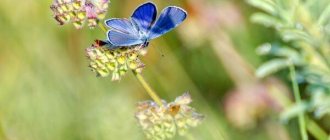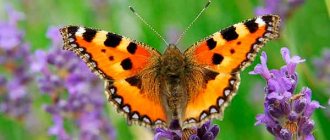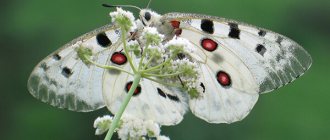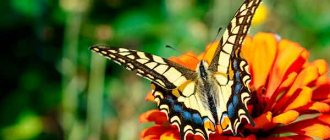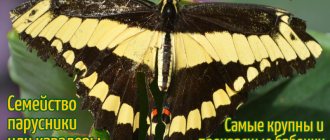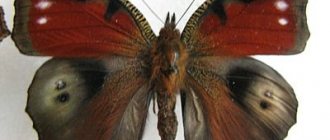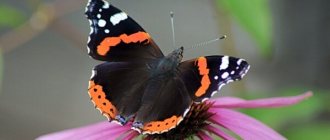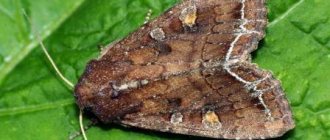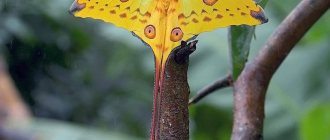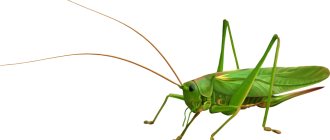Nature has many creatures of amazing beauty and grace. One of them is a bright peacock butterfly. It is easy to distinguish it from other representatives of the order Lepidoptera by its characteristic pattern. On the wings there are four blue eyes with a dark border. The insect lives throughout Eurasia and can easily be found in early spring in a garden or park. The butterfly feeds on plant nectar and gives preference to buddleia, a shrub with white or lilac fragrant flowers.
Description and appearance
The peacock eye is a butterfly belonging to the nymphalidae family. These are medium-sized insects with a wingspan of 55 – 62 mm. Males are usually somewhat smaller than females.
Butterflies have a recognizable bright color. On the wings of a bright orange-brown color with a dark edging along the edges, a pattern is clearly visible - blue circles framed by a yellow border, similar to eyes. The insect got its name for this feature. This color serves as good protection from enemies. In case of danger, the butterfly opens its wings, scaring away predators.
The brightness of the color largely depends on weather conditions during the development of the pupa. The cooler it was outside, the paler the butterfly emerging from the cocoon would be. And vice versa, the higher the temperature, the brighter the individual will be born.
Appearance
But the reverse side of the wings is a nondescript, dark brown-gray shade. Having folded its wings, the butterfly looks like a dry leaf or sliver and becomes almost invisible against the background of tree bark.
The body of the butterfly with eyes on the wings is shaggy and dark brown. Of the three pairs of legs, only two are used for movement; the front pair is underdeveloped.
The peacock eye does not have a protected status and is not listed in the Red Book. There are many of these butterflies in the world, but since the end of the 20th century the population has been steadily declining. In some regions the situation is approaching critical, so it is time to take measures to protect this species of Lepidoptera.
Habitat
The day peacock butterfly prefers regions with temperate and subtropical climates and is practically not found in the tropics, deserts and the far north. The peacock eye lives in Eurasia, Japan, most of these butterflies are in Germany. But this species is not found in North Africa, despite quite suitable climatic conditions.
Bright beauties most often choose places near forests, rich in flowers and well lit by the sun. They can be found in meadows, forest clearings, and garden plots.
Butterflies rarely fly into the thicket of the forest - there is little sun there, and besides, you can damage your wings while making your way through the dense foliage. The banks of ponds, rivers and lakes, gardens and parks, even city streets - you can find the peacock butterfly everywhere. They are also found in mountainous areas, but practically do not rise to a height of more than 2500 m.
Home content
The prevalence of the peacock eye is quite high; it can easily be found in clearings, meadows, forest edges, parks, gardens and river banks. It is useful for everyone to know about this butterfly, so even a child at school may be asked to prepare information about it in the form of a short story, message or report.
But sometimes the acquaintance with the butterfly occurs so closely that they decide to keep it at home. In order not to cause harm to the insect, you will have to care for it according to the following rules:
- Nutrition. The butterfly needs to be fed 1-2 times a day. As food, you can use nettle, raspberry, hop, willow or burdock leaves, as well as chopped bananas, oranges and other overripe fruits. A real treat for the butterfly will be natural honey diluted in water in a ratio of 1:10. You can use sugar instead of honey.
- Breeding. Butterflies can breed in captivity. To do this, the male and female need to be placed in a warm, spacious place with high humidity and good ventilation, where there is enough food and fresh leaves for laying eggs. Their mating can last from 30 minutes to 8 hours. If everything goes well, after a while caterpillars will appear, which will need to be fed with fresh grass. When pupating, they will have to be moved separately and hung upside down. You can place a wet towel nearby to increase air humidity.
- Wintering. The lifespan of an insect can be increased only by sending it into hibernation for the winter. To do this, you need to feed him, place him in a box with holes for ventilation and send him to a cool room where the temperature is in the range from 0 to 5 degrees Celsius. If the butterfly overwinters in a warm place, its life processes will not slow down enough, and it may grow old and die during hibernation.
Great night peacock eye
The great night peacock eye butterfly or pear peacock eye butterfly is not a close relative of the peacock eye butterfly, as its name might lead you to believe. This insect belongs to the peacock eye family. The Great Peacock's Eye is a large butterfly with a wingspan of 12 cm in males and 16 cm in females. They live in Central and Southern Europe, Asia Minor, Iran, and the Caucasus. Representatives of this species are considered the largest among moths in Europe and Russia.
Unlike the Peacock's eye, the pear peacock's eye is colored in grayish-beige and light brown tones. There is a pattern in the form of circles on the wings, but due to the calmer colors they do not look as impressive. The Great Nocturnal Peacock's Eye is included in the Red Book of Ukraine and is protected in some Russian regions.
Caterpillars of the pear peacock eye feed on the leaves of fruit trees: pear, cherry, plum, apple, quince. They can also settle on maple, ash or elm.
Hearing organs
Butterflies hear through their abdomen, since their “ears” are located in the dimples on the sides of the third segment of the chest or the first segment of the abdomen.
The “ears” of butterflies are formed by a thin leathery membrane, which is stretched over a ring. Beneath the membrane are bubble-like tracheas, and nerves connect to them. When the sound wave reaches the butterfly, the membranes begin to vibrate. The tracheal vesicles pick up this vibration and transmit it along the nerves to the brain, which decides what to do.
Lesser night peacock
The Lesser Night Peacock is another butterfly from the Peacock-eye butterfly family. The wingspan of the insect is from 6 to 8 cm, the color of males is orange-red with a silvery tint, females are reddish-gray. A recognizable pattern on the wings is also present. Habitat: all of Europe, Transcaucasia and the Caucasus, southern and central Siberia, northern regions of China, Primorye, Mongolia.
Lesser night peacock
Female butterflies are exclusively nocturnal; males can fly during the day. The caterpillars' diet consists of the foliage of a large number of trees and shrubs, including:
- alder;
- birch;
- sea buckthorn;
- Apple tree;
- hawthorn;
- dogwood;
- nut;
- poplar;
- Rowan.
The insect waits out the winter while in the pupal stage. Summer begins in late April – early May.
Features of reproduction
The breeding process occurs once a year for butterflies in the north, twice a year for butterflies in the south. At the end of April they lay several hundred eggs. To do this, they most often use the underside of a nettle leaf .
In May, black hairy larvae appear, covered with spines and small white dots. They live in a common nest made of leaves on plants, which are entwined with the silky threads they produce. They feed on herbs.
In July, the caterpillars crawl away and live separately. Around September, they develop into pupae that hang upside down on plants or fences and walls. They look angular, have a dark color from gray-green to brown and a golden tint, and have two rows of shiny spines. And after 1-2 weeks, the transformation into adult insects occurs.
Lifestyle
The peacock eye is a butterfly that is active during the daytime. As soon as the sun goes down, the insect looks for shelter to spend the night. The insect spends most of the day in flight. She can fly by flapping her wings, or simply float in the air while maintaining her strength.
During their flight, butterflies spend a lot of energy, which they replenish by basking in the warm rays of the sun. That is why it is much easier to see them on a sunny day than on cloudy weather, when they prefer to remain alone, saving energy.
Moreover, if the cool rainy period drags on, the butterfly may go into short-term hibernation. The state of suspended animation lasts up to 5–7 days, and as soon as the sun comes out and the air warms up, the butterfly returns to active life.
Butterfly wintering
One of the features of this species is the wintering of adult individuals. The second generation, born at the end of August or September, with the onset of cold weather begins to look for shelter where they can wait out the winter. A heap of fallen leaves, the space between the trunk and bark of a tree, a crevice in a wooden building, an attic or a balcony can become a shelter for a Peacock's eye.
Having found shelter, the butterfly folds its wings and falls into a stupor. Her life processes are suspended. She spends the winter in this state and wakes up in the spring, when the air warms up enough. An early thaw is very dangerous. The insect wakes up and flies out of its shelter, but very soon dies from returning frosts or from hunger. Only in rare cases does a butterfly manage to find a new home and continue wintering in order to wake up with the arrival of a real warm spring.
Defense mechanism
Like other butterflies, the Peacock Eye has many enemies. These are birds, insect predators, lizards, rodents. When attacked by an enemy, the insect is often saved by its unusual colors. The butterfly suddenly opens its wings and suddenly bright eyes appear in front of the hunter. Such a picture disorients the attacker for some time, and the butterfly manages to fly away.
Reproduction and lifespan
The mating process in Peacock-eye butterflies is preceded by a courtship period, which consists of joint flights and mating dances. After fertilization, the female lays 100 – 300 eggs. Laying is most often done on the back side of the leaves of the food plant.
After 7–12 days, larvae appear. Peacock eye caterpillars are black with white dots and their entire body is covered with hard spines. Caterpillars live in large broods and actively eat most of the day, sometimes stopping for a short rest. The larval stage lasts 25–30 days, during which time 5 molts occur. Before pupation, the caterpillars crawl away.
Caterpillar
The pupal stage of the peacock eye lasts 10–15 days, after which an adult butterfly emerges from the cocoon.
How long the Peacock butterfly lives depends largely on weather conditions and climate. But in general, representatives of this species are considered long-livers. They can live for about a year, which is a huge period of time for lepidopterans.
How to deal with meadow moth on the site
What measures to combat the meadow moth should a summer resident take to reduce damage from the pest’s activities?
Since this butterfly hides on weeds in winter, the less attention you pay to current weeding, the greater the risk of encountering the pest next year.
Moreover, caterpillars that feed on weeds such as field bindweed, quinoa, white pigweed, and acorn grass, which develop more actively and freeze out less in the cold season. Therefore, if you promptly get rid of the above-mentioned weeds, you will simply deprive the caterpillars of a significant portion of their food.
The greatest damage to young plants and planted seedlings is caused by the first early spring generation of the moth. In the dry and hot May weather, the appetite of the caterpillars increases sharply and they begin to intensively feed on the juices of garden plants.
To prevent the appearance of moths on the site during this period, I advise destroying weeds not only on the site itself, but also along its perimeter, along the fence and greenhouse. It is better to have time to do the work before the beginning of summer and the invasion of butterflies. You can also eradicate weeds using drugs like Hurricane Forte or Glyphos.
After contact with weed leaves, the active ingredients of such preparations penetrate into all parts of the plants, causing their complete death. Within a week or a week and a half, the first effect of their action appears - the weeds gradually turn yellow and wither, and after a month they die completely.
The use of herbicides has an obvious advantage over conventional mowing. After all, when a female meadow moth does not find a suitable place to lay eggs, she simply flies a little to the side. If you use a herbicide, then they manage to lay a clutch, but the larvae that emerge from the eggs are deprived of the necessary nutrition and quickly die.
Other agrotechnical measures to combat the meadow moth include digging between rows, regular loosening and hilling of plants. Such complex measures can reduce the pest population by 1.5-2 times. Young larvae and caterpillars, being covered with soil, do not have the strength to get out and suffocate.
To protect the plantings from the meadow moth, it is useful to plant them with beans. The fact is that the hard and sharp hairs that cover the leaves, stems and petioles of beans pose a mortal danger to the caterpillars of the pest.
But during periods of the most active moth reproduction, agrotechnical methods are not enough. How to determine when it is time to resort to the help of heavy artillery? Calculate the average number of caterpillars per square meter of garden. If it is 5 or higher, then it’s time to sound the alarm.
In this case, insecticides like Kinmiks or Fufanon are used.
Such a well-known biological product as Lepidocide, which is used on vegetable and green crops even 5 days before harvesting, also works quite well against the caterpillars of this type of butterfly. However, remember that since this drug belongs to the biological class, it is used only at temperatures not lower than +13 degrees. Insecticides are sprayed not only on the vegetable plants themselves, but also on the grass along the edge of the site, if it is infested with moth caterpillars.
Keep in mind that if a meadow moth has started to take over your gardening neighbor’s plot, then very soon he will visit you. Therefore, we need to fight this pest together and systematically, helping and supporting each other in this difficult matter. This will protect the crop of the current season and significantly reduce the number of pests next year.
Nutrition of butterflies and caterpillars
There is nothing unusual in the diet of Peacock butterflies; they feed on the same thing as most representatives of the order Lepidoptera. The basis of nutrition for adults is nectar. The most attractive plants:
- buddleia;
- clover;
- elder;
- marjoram;
- thyme;
- marigold;
- felt burdock;
- dandelion;
- sivets;
- thistle
In addition to nectar, butterflies are attracted to fermented juice of overripe fruits and tree sap.
Unlike peacock eye caterpillars, which prefer to feed on trees and forest plants, peacock eye caterpillars eat leaves:
- nettle;
- hemp;
- hops;
- and you;
- willows;
- raspberries
The caterpillars of the peacock butterfly prefer nettles. It is on this plant that females most often lay eggs so that the emerging larvae can immediately begin to eat and grow.
Fighting methods
Due to the great environmental damage these insects cause, many methods have been developed to combat them. Highlight:
- methods associated with the use of chemicals;
- methods associated with mechanical methods of control;
- traditional methods to destroy harmful organisms.
Each of them has its own advantages and disadvantages, which are worth considering separately.
Specialty Chemicals
The use of specialized chemicals involves the use of:
- neonictinoids;
- organophosphorus compounds;
- pyrethroids.
They are sold in agricultural stores and used according to the instructions specified by the manufacturer. Advantages of the method:
- efficiency;
- you don't need to spend a lot of effort.
Minuses:
harmfulness.
Mechanical methods of control
Unlike chemicals, mechanical methods are harmless to the environment and humans, but are extremely energy intensive. They take a lot of time and effort. Mechanical methods include:
- Removing caterpillars manually by collecting and further destroying them.
- The use of special adhesive belts that prevent the movement of adult insects and caterpillars along tree trunks.
- Destruction of pupae that are concentrated in one place in large quantities.
Folk remedies
Folk remedies are less effective than their chemical counterparts, but they do not harm the environment. Folk remedies include:
A decoction based on hot pepper.
Pour one hundred grams of chopped pepper with one liter of water. Boil for an hour, then let the broth brew for two days. Mash the pepper and strain. Add half a glass of broth to 10 liters of liquid, then spray the plantings with it. To better retain the liquid on the surface, add a little soap to the solution.
Powder made from tansy.
Dry the tansy and grind it to a powdery state. Sprinkle the resulting powder onto plants that need protection.
A decoction based on burdock leaves.
Finely chop the leaves and place them in a large container. A bucket is best suited for these purposes. Fill the container with leaves to a third of the total volume. Fill with water. Let it brew for three days, after which we spray it with the strained decoction of the plant.
Harm to plants
It is a fairly common belief that peacock butterfly caterpillars cause damage to garden and vegetable crops. Therefore, some gardeners destroy them along with other pests. However, neither larvae nor adult butterflies of this species pose any threat to plantings.
Quite the contrary - butterflies pollinate many of the plants growing in the garden, and caterpillars eat nettles, which interfere with the growth of crops. The only garden crop on which peacock eye caterpillars can be found is raspberries. But insects do not cause any significant harm to the plant.
Total number
The order Lepidoptera undoubtedly stands out among taxa of a similar rank in terms of species diversity. Lepidoptera are one of the largest groups of insects, including, as of August 2013, 158,570 species, including 147 fossil taxa. It is estimated that up to 100,000 species remain still unknown to science and, thus, the total number of lepidopteran species existing on the planet can be estimated at approximately 200,000 - 225,000 species. There are 2,166 genera and 8,879 species found in Russia.
Lepidoptera are very diverse, and most of their species are poorly studied. Some of the described species are known from finds from a single locality or even from a single specimen. A true estimate of the total number of species in existence will never be known because many species became extinct before they were discovered. The taxonomy of butterflies presented in various works reflects the different views of their authors and is, without a doubt, debatable.
There are disputes regarding the systematic position or the need to maintain the status of certain subspecies or species. DNA studies suggest that some of the currently known species must be separated. A well-known example is where the seemingly identical Colias alfacariensis and Colias hyale, previously thought to be one species, were split into two after significant differences in the structure of their caterpillars and pupae were discovered.

